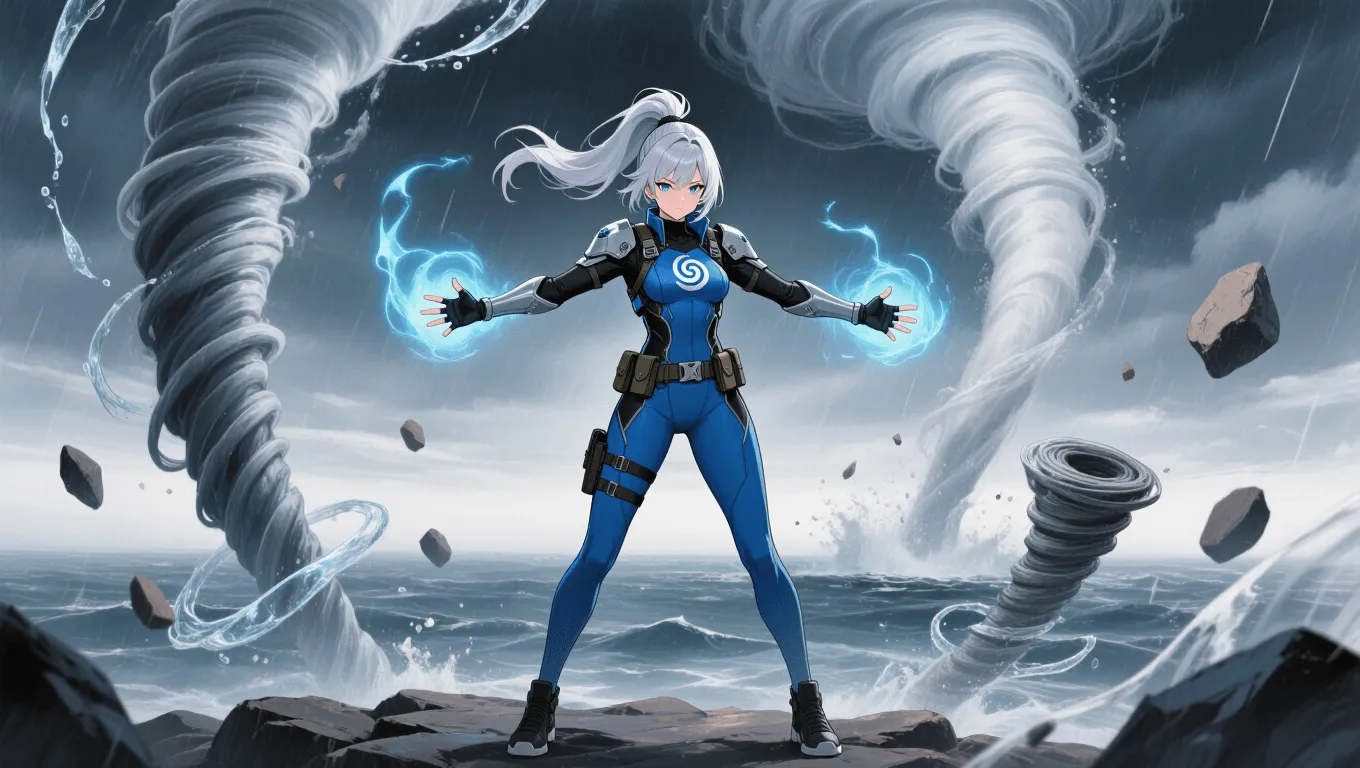Cyclone Creation

Cyclone Creation Video Demo 🎬
Table of Contents
What Is Cyclone Creation
Cyclone Creation is a wind-based superpower that allows a user to generate and control spinning columns of air—from compact dust devils to city-scale cyclones. Within the first moments of activation, the user manipulates air pressure and airflow to form a rotating vortex, shaping speed, size, and direction. Unlike general aerokinesis or broad weather manipulation, Cyclone Creation focuses on producing coherent, rotating wind structures for offense, defense, and mobility. Practitioners refine the art of cyclogenesis, balancing barometric pressure and angular momentum to maintain a stable eye of the storm while harnessing gale-force winds.
As a specialized branch of wind manipulation, Cyclone Creation overlaps with tornado creation, waterspout formation, and vortex control. Skilled users can spin up micro-cyclones for surgical strikes or deploy large-scale tempests as major battlefield hazards. For readers exploring related abilities, see the full catalog in the superpower wiki or try your luck with the random superpower generator.
Core abilities of Cyclone Creation
Cyclogenesis on command
The core capability is inducing rotation in surrounding air to create a vortex. This involves adjusting pressure gradients to pull air inward, then deflecting it via the Coriolis-like control of the user’s intent. The result is a rotating column with controllable diameter, height, and rotational velocity.
Pressure and airflow modulation
Users fine-tune barometric pressure to maintain vortex integrity. By micromanaging inflow and outflow, they stabilize the core, prevent premature dissipation, and mitigate collateral damage. This precision enables swapping between tight, high-speed spinners and broader, slower cyclones that push rather than shred.
Offensive vortex shaping
A cyclone can function like a mobile blender or battering ram:
-
Shear and debris strike: High wind shear accelerates debris, multiplying impact force.
-
Vacuum suction: Negative pressure draws targets off balance or into containment rings.
-
Centrifugal flinging: Objects captured near the rim can be hurled outward with extreme momentum.
Defensive barriers
Rotating air walls deflect projectiles, scatter gases, and dissipate flames by starving them of oxygen or redirecting heat columns. A maintained vortex acts as a dynamic shield, shedding incoming threats along its periphery.
Mobility and terrain control
By tilting the vortex axis, users create moving cyclones that herd opponents, open paths through smoke or fog, and carve temporary corridors. Some practitioners “ride” a controlled funnel, achieving limited flight or rapid repositioning.
Elemental blending
Cyclones can entrain particulates or fluids:
-
Sand or dust: Becomes cutting grit—effective against armor and constructs.
-
Water: Forms waterspouts for aquatic combat or crowd control with soaking, chilling winds.
-
Electric arcs: Ionized air can carry lightning strikes when paired with electrokinetic allies.
Sensory and environmental awareness
Cyclone users become adept at reading wind signatures, detecting pressure dips, and predicting turbulence. This battlefield awareness anticipates ranged attacks, incoming aircraft, or sudden thermal shifts.
Application / Tactical Advantages in Combat
Area denial and zoning
A maintained cyclone establishes “no-go” zones. Opponents must either detour, waste time dismantling the storm, or risk injury. This is invaluable for protecting VIPs, sealing chokepoints, or guarding objectives.
Disruption of formations
Rotational winds scatter shield lines, break phalanxes, and separate heavy units from support. The resulting chaos creates windows for allies with precision strikes or stealth approaches.
Counter-missile and projectile control
Cyclones degrade ballistic accuracy, push explosives off course, and reduce arrow or bullet velocity. Against slower munitions or gas canisters, suction and sidewinds can capture and eject threats safely.
Firefighting and hazard management
By managing oxygen flow, a user can smother localized flames or redirect heat plumes away from civilians. Conversely, careless use can fan wildfires—discipline matters.
Vertical battlefield shaping
Updrafts and downdrafts from a cyclone alter aerial paths, threatening flyers reliant on steady lift. Grounded foes can be lifted briefly, losing traction and exposing weak points.
Stealth and misdirection
Wind roar, dust clouds, and reduced visibility mask allied movements. A user can spin decoy cyclones to draw attention while a smaller, silent vortex approaches from the flank.
Level: Level 1 🏙️, Level 2 🌇, Level 3 🌃
Level 1: Novice Cyclone Spinner

-
Profile: Learner with basic aerokinesis and short-duration vortex creation.
-
Capabilities: Can generate waist- to roof-height whirlwinds with limited control. Effective for tripping foes, blinding with dust, and deflecting thrown objects.
-
Range & Duration: 5–15 meters; 10–30 seconds sustained with intense focus.
-
Risks: Over-rotation leads to blowback; user may suffer dizziness or ear-pressure pain. Collateral debris is common.
-
Training goals: Pressure discipline, controlled spin-up/spin-down, debris awareness, and safe crowd-control drills.
Level 2: Adept Tempest Architect

-
Profile: Battle-ready controller with multi-vortex command and terrain integration.
-
Capabilities: Simultaneously sustain 2–3 stable cyclones; shape tight funnels for cutting force or broad walls for defense. Can create waterspouts near bodies of water and manipulate microbursts to stun groups.
-
Range & Duration: 30–100 meters; storms last several minutes with rhythmic breathing and stance anchoring.
-
Risks: Tunnel vision during multi-tasking, localized hypoxia if over-sealing the vortex, and structural damage from entrained debris.
-
Training goals: Multi-tasking under stress, target discrimination, aerial partner coordination, and safe extraction techniques.
Level 3: Master of Cyclogenesis

-
Profile: Strategic controller able to alter regional wind patterns and summon large, directed cyclones.
-
Capabilities: City-block coverage; precision “eye of the storm” placement for ally safe zones; controlled wind shear to ground aircraft; seamless blending with rain, lightning, or sleet when supported by weather manipulation.
-
Range & Duration: 200+ meters to multi-kilometer influence in favorable conditions; sustained engagement for 10–20 minutes with staged energy cycles.
-
Risks: Rapid exhaustion, environmental repercussions, and legal/ethical liabilities. Misjudged pressure gradients can escalate into uncontrolled storms.
-
Training goals: Ethical scenario planning, meteorological modeling, emergency response coordination, and cooldown protocols.
Limitations of using the Cyclone Creation
-
Energy and stamina drain: Sustaining high-velocity rotation taxes cardiovascular and muscular systems. Overexertion leads to tremors, nausea, or temporary hearing loss.
-
Line-of-sight sensitivity: While advanced users can “feel” wind, precision targeting is best with visual confirmation. Obstructions degrade control.
-
Environmental dependency: Dry, thin, or turbulent atmospheres complicate cyclogenesis. Underground or sealed environments limit usable air volume.
-
Collateral management: Flying debris can harm civilians and allies. Responsible users pre-clear zones or constrain vortex diameter to surgical scales.
-
Acoustic signature: Cyclones are loud. Stealth missions require micro-cyclones, staggered bursts, or sound-dampening allies.
-
Weather feedback loops: Large-scale manipulation can inadvertently seed thunderstorms, hail, or unsafe wind shear if not carefully wound down.
-
Equipment interference: The vortex can disrupt drones, parachutes, gliders, and unshielded electronics via dust ingress or static buildup.
Weakness against what other superpowers
-
Gravity Manipulation: Increases effective weight and reduces loft, flattening vortex columns and neutralizing lift. Heavy-grav pulses collapse the eye and stop rotation.
-
Earth Manipulation | Geokinesis: Rapidly raised earthworks, stone domes, or spires block airflow, choking the cyclone’s intake.
-
Sound Dampening | Silencing Fields: Interfere with vibrational cues the user relies on to read airflow, reducing fine control and reaction time.
-
Water Domination | Hydrokinesis (high humidity control): Saturated air becomes heavy and harder to spin. Super-cooled mist can clog the cyclone with ice crystals.
-
Vacuum Bubbles | Pressure Nullification: Localized pressure equalization cancels the gradient that feeds the vortex.
-
Thermokinesis (stable inversions): Imposed temperature layers (inversions) prevent vertical development, limiting cyclone height and power.
-
Elastic Barriers & Forcefields: Energy domes and elastic membranes blunt debris and shear, making cyclones inefficient as a primary breach tool.
Synergistic Power Combos
-
Electrokinetic partners: Ionized air inside a cyclone guides controlled lightning strikes along the vortex spine, creating a stunning, nonlethal crowd-control option or a precise EMP conduit against drones.
-
Cryokinesis overlays: Rapid cooling on the cyclone’s perimeter forms sleet or ice needles. The result is a shredding storm that also reduces fire spread.
-
Hydrokinesis support: Waterspouts convert the vortex into a mobility-denial tool, flooding paths and reducing visibility while keeping allies safe in the eye.
-
Sound Manipulation: Sonic pulses travel along the rotating walls, disorienting foes trapped inside without harming allies in the calm center.
-
Plant Manipulation: Vortex-driven seed dispersal lays down fast-growing barriers behind withdrawing allies, shaping the terrain mid-fight.
-
Light-Bending/Illusion: Dust-laden cyclones act as projection screens for refracted light, masking ally positions or projecting decoys in the storm.
Known Users
-
Red Tornado (DC Comics): A classic android hero associated with high-level wind and tornado tactics. Learn more about the character on Wikipedia.
-
Typhoon-class villains and storm shamans (various media): Many antagonists employ vortex control for intimidation, crowd panic, and infrastructure disruption.
-
Air monks and martial wind adepts (fantasy settings): Trained practitioners use disciplined breathing and stances to create controlled, low-collateral cyclones that emphasize protection and mobility.
SEO Notes & Related Terms: Cyclone Creation is closely related to aerokinesis, weather manipulation, storm summoning, tornado generation, vortex control, atmospheric pressure manipulation, wind shear management, microburst tactics, dust devil formation, and waterspout creation. For connected abilities and inspiration for character builds, explore the superpower wiki or roll a new concept with the random superpower generator.
